Carlos Guestrin
Carnegie Mellon University
DeepScholar-Bench: A Live Benchmark and Automated Evaluation for Generative Research Synthesis
Aug 27, 2025Abstract:The ability to research and synthesize knowledge is central to human expertise and progress. An emerging class of systems promises these exciting capabilities through generative research synthesis, performing retrieval over the live web and synthesizing discovered sources into long-form, cited summaries. However, evaluating such systems remains an open challenge: existing question-answering benchmarks focus on short-form factual responses, while expert-curated datasets risk staleness and data contamination. Both fail to capture the complexity and evolving nature of real research synthesis tasks. In this work, we introduce DeepScholar-bench, a live benchmark and holistic, automated evaluation framework designed to evaluate generative research synthesis. DeepScholar-bench draws queries from recent, high-quality ArXiv papers and focuses on a real research synthesis task: generating the related work sections of a paper by retrieving, synthesizing, and citing prior research. Our evaluation framework holistically assesses performance across three key dimensions, knowledge synthesis, retrieval quality, and verifiability. We also develop DeepScholar-base, a reference pipeline implemented efficiently using the LOTUS API. Using the DeepScholar-bench framework, we perform a systematic evaluation of prior open-source systems, search AI's, OpenAI's DeepResearch, and DeepScholar-base. We find that DeepScholar-base establishes a strong baseline, attaining competitive or higher performance than each other method. We also find that DeepScholar-bench remains far from saturated, with no system exceeding a score of $19\%$ across all metrics. These results underscore the difficulty of DeepScholar-bench, as well as its importance for progress towards AI systems capable of generative research synthesis. We make our code available at https://github.com/guestrin-lab/deepscholar-bench.
metaTextGrad: Automatically optimizing language model optimizers
May 24, 2025Abstract:Large language models (LLMs) are increasingly used in learning algorithms, evaluations, and optimization tasks. Recent studies have shown that using LLM-based optimizers to automatically optimize model prompts, demonstrations, predictions themselves, or other components can significantly enhance the performance of AI systems, as demonstrated by frameworks such as DSPy and TextGrad. However, optimizers built on language models themselves are usually designed by humans with manual design choices; optimizers themselves are not optimized. Moreover, these optimizers are general purpose by design, to be useful to a broad audience, and are not tailored for specific tasks. To address these challenges, we propose metaTextGrad, which focuses on designing a meta-optimizer to further enhance existing optimizers and align them to be good optimizers for a given task. Our approach consists of two key components: a meta prompt optimizer and a meta structure optimizer. The combination of these two significantly improves performance across multiple benchmarks, achieving an average absolute performance improvement of up to 6% compared to the best baseline.
Societal Impacts Research Requires Benchmarks for Creative Composition Tasks
Apr 09, 2025Abstract:Foundation models that are capable of automating cognitive tasks represent a pivotal technological shift, yet their societal implications remain unclear. These systems promise exciting advances, yet they also risk flooding our information ecosystem with formulaic, homogeneous, and potentially misleading synthetic content. Developing benchmarks grounded in real use cases where these risks are most significant is therefore critical. Through a thematic analysis using 2 million language model user prompts, we identify creative composition tasks as a prevalent usage category where users seek help with personal tasks that require everyday creativity. Our fine-grained analysis identifies mismatches between current benchmarks and usage patterns among these tasks. Crucially, we argue that the same use cases that currently lack thorough evaluations can lead to negative downstream impacts. This position paper argues that benchmarks focused on creative composition tasks is a necessary step towards understanding the societal harms of AI-generated content. We call for greater transparency in usage patterns to inform the development of new benchmarks that can effectively measure both the progress and the impacts of models with creative capabilities.
One-Minute Video Generation with Test-Time Training
Apr 07, 2025



Abstract:Transformers today still struggle to generate one-minute videos because self-attention layers are inefficient for long context. Alternatives such as Mamba layers struggle with complex multi-scene stories because their hidden states are less expressive. We experiment with Test-Time Training (TTT) layers, whose hidden states themselves can be neural networks, therefore more expressive. Adding TTT layers into a pre-trained Transformer enables it to generate one-minute videos from text storyboards. For proof of concept, we curate a dataset based on Tom and Jerry cartoons. Compared to baselines such as Mamba~2, Gated DeltaNet, and sliding-window attention layers, TTT layers generate much more coherent videos that tell complex stories, leading by 34 Elo points in a human evaluation of 100 videos per method. Although promising, results still contain artifacts, likely due to the limited capability of the pre-trained 5B model. The efficiency of our implementation can also be improved. We have only experimented with one-minute videos due to resource constraints, but the approach can be extended to longer videos and more complex stories. Sample videos, code and annotations are available at: https://test-time-training.github.io/video-dit
Obfuscated Activations Bypass LLM Latent-Space Defenses
Dec 12, 2024Abstract:Recent latent-space monitoring techniques have shown promise as defenses against LLM attacks. These defenses act as scanners that seek to detect harmful activations before they lead to undesirable actions. This prompts the question: Can models execute harmful behavior via inconspicuous latent states? Here, we study such obfuscated activations. We show that state-of-the-art latent-space defenses -- including sparse autoencoders, representation probing, and latent OOD detection -- are all vulnerable to obfuscated activations. For example, against probes trained to classify harmfulness, our attacks can often reduce recall from 100% to 0% while retaining a 90% jailbreaking rate. However, obfuscation has limits: we find that on a complex task (writing SQL code), obfuscation reduces model performance. Together, our results demonstrate that neural activations are highly malleable: we can reshape activation patterns in a variety of ways, often while preserving a network's behavior. This poses a fundamental challenge to latent-space defenses.
MoSH: Modeling Multi-Objective Tradeoffs with Soft and Hard Bounds
Dec 09, 2024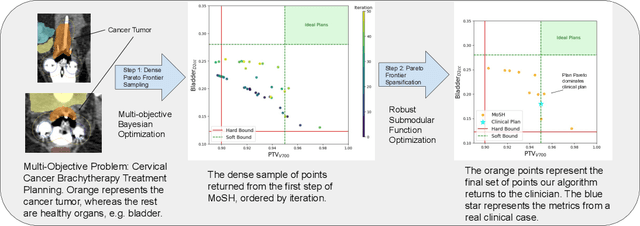
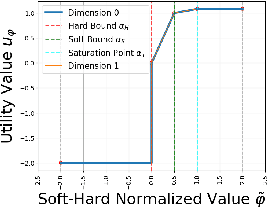

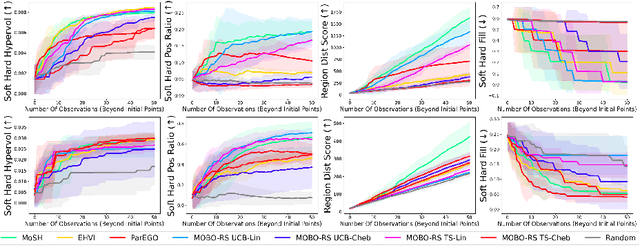
Abstract:Countless science and engineering applications in multi-objective optimization (MOO) necessitate that decision-makers (DMs) select a Pareto-optimal solution which aligns with their preferences. Evaluating individual solutions is often expensive, necessitating cost-sensitive optimization techniques. Due to competing objectives, the space of trade-offs is also expansive -- thus, examining the full Pareto frontier may prove overwhelming to a DM. Such real-world settings generally have loosely-defined and context-specific desirable regions for each objective function that can aid in constraining the search over the Pareto frontier. We introduce a novel conceptual framework that operationalizes these priors using soft-hard functions, SHFs, which allow for the DM to intuitively impose soft and hard bounds on each objective -- which has been lacking in previous MOO frameworks. Leveraging a novel minimax formulation for Pareto frontier sampling, we propose a two-step process for obtaining a compact set of Pareto-optimal points which respect the user-defined soft and hard bounds: (1) densely sample the Pareto frontier using Bayesian optimization, and (2) sparsify the selected set to surface to the user, using robust submodular function optimization. We prove that (2) obtains the optimal compact Pareto-optimal set of points from (1). We further show that many practical problems fit within the SHF framework and provide extensive empirical validation on diverse domains, including brachytherapy, engineering design, and large language model personalization. Specifically, for brachytherapy, our approach returns a compact set of points with over 3% greater SHF-defined utility than the next best approach. Among the other diverse experiments, our approach consistently leads in utility, allowing the DM to reach >99% of their maximum possible desired utility within validation of 5 points.
The Extractive-Abstractive Spectrum: Uncovering Verifiability Trade-offs in LLM Generations
Nov 26, 2024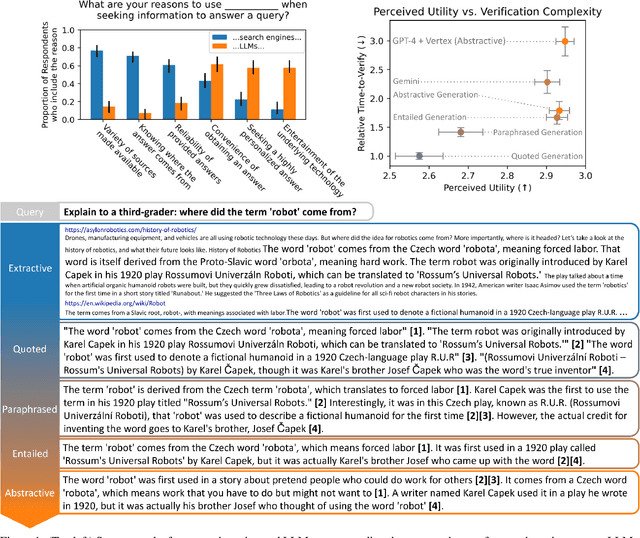

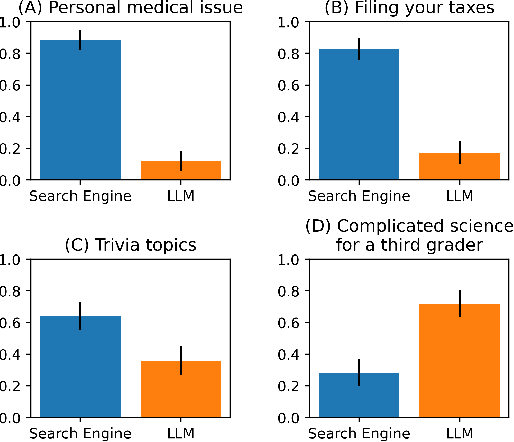

Abstract:Across all fields of academic study, experts cite their sources when sharing information. While large language models (LLMs) excel at synthesizing information, they do not provide reliable citation to sources, making it difficult to trace and verify the origins of the information they present. In contrast, search engines make sources readily accessible to users and place the burden of synthesizing information on the user. Through a survey, we find that users prefer search engines over LLMs for high-stakes queries, where concerns regarding information provenance outweigh the perceived utility of LLM responses. To examine the interplay between verifiability and utility of information-sharing tools, we introduce the extractive-abstractive spectrum, in which search engines and LLMs are extreme endpoints encapsulating multiple unexplored intermediate operating points. Search engines are extractive because they respond to queries with snippets of sources with links (citations) to the original webpages. LLMs are abstractive because they address queries with answers that synthesize and logically transform relevant information from training and in-context sources without reliable citation. We define five operating points that span the extractive-abstractive spectrum and conduct human evaluations on seven systems across four diverse query distributions that reflect real-world QA settings: web search, language simplification, multi-step reasoning, and medical advice. As outputs become more abstractive, we find that perceived utility improves by as much as 200%, while the proportion of properly cited sentences decreases by as much as 50% and users take up to 3 times as long to verify cited information. Our findings recommend distinct operating points for domain-specific LLM systems and our failure analysis informs approaches to high-utility LLM systems that empower users to verify information.
Benchmarking Distributional Alignment of Large Language Models
Nov 08, 2024



Abstract:Language models (LMs) are increasingly used as simulacra for people, yet their ability to match the distribution of views of a specific demographic group and be \textit{distributionally aligned} remains uncertain. This notion of distributional alignment is complex, as there is significant variation in the types of attributes that are simulated. Prior works have underexplored the role of three critical variables -- the question domain, steering method, and distribution expression method -- which motivates our contribution of a benchmark explicitly addressing these dimensions. We construct a dataset expanding beyond political values, create human baselines for this task, and evaluate the extent to which an LM can align with a particular group's opinion distribution to inform design choices of such simulation systems. Our analysis reveals open problems regarding if, and how, LMs can be used to simulate humans, and that LLMs can more accurately describe the opinion distribution than simulate such distributions.
Model Equality Testing: Which Model Is This API Serving?
Oct 26, 2024Abstract:Users often interact with large language models through black-box inference APIs, both for closed- and open-weight models (e.g., Llama models are popularly accessed via Amazon Bedrock and Azure AI Studio). In order to cut costs or add functionality, API providers may quantize, watermark, or finetune the underlying model, changing the output distribution -- often without notifying users. We formalize detecting such distortions as Model Equality Testing, a two-sample testing problem, where the user collects samples from the API and a reference distribution and conducts a statistical test to see if the two distributions are the same. We find that tests based on the Maximum Mean Discrepancy between distributions are powerful for this task: a test built on a simple string kernel achieves a median of 77.4% power against a range of distortions, using an average of just 10 samples per prompt. We then apply this test to commercial inference APIs for four Llama models, finding that 11 out of 31 endpoints serve different distributions than reference weights released by Meta.
Text2SQL is Not Enough: Unifying AI and Databases with TAG
Aug 27, 2024



Abstract:AI systems that serve natural language questions over databases promise to unlock tremendous value. Such systems would allow users to leverage the powerful reasoning and knowledge capabilities of language models (LMs) alongside the scalable computational power of data management systems. These combined capabilities would empower users to ask arbitrary natural language questions over custom data sources. However, existing methods and benchmarks insufficiently explore this setting. Text2SQL methods focus solely on natural language questions that can be expressed in relational algebra, representing a small subset of the questions real users wish to ask. Likewise, Retrieval-Augmented Generation (RAG) considers the limited subset of queries that can be answered with point lookups to one or a few data records within the database. We propose Table-Augmented Generation (TAG), a unified and general-purpose paradigm for answering natural language questions over databases. The TAG model represents a wide range of interactions between the LM and database that have been previously unexplored and creates exciting research opportunities for leveraging the world knowledge and reasoning capabilities of LMs over data. We systematically develop benchmarks to study the TAG problem and find that standard methods answer no more than 20% of queries correctly, confirming the need for further research in this area. We release code for the benchmark at https://github.com/TAG-Research/TAG-Bench.
 Add to Chrome
Add to Chrome Add to Firefox
Add to Firefox Add to Edge
Add to Edge